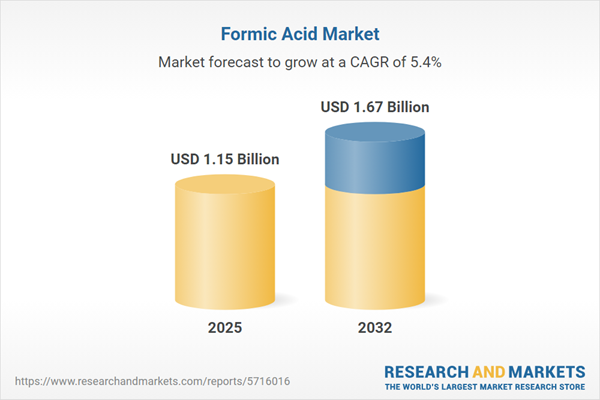Speak directly to the analyst to clarify any post sales queries you may have.
Senior executives in the formic acid market operate within a landscape defined by sustainability, regulatory complexity, and rapid technology advances. Effective decision-making depends on reliable, actionable market intelligence that supports strategic growth, operational compliance, and long-term resilience.
Formic Acid Market Snapshot
The global formic acid market is experiencing persistent growth, reaching a value of USD 1.09 billion in 2024, with projections indicating expansion to USD 1.15 billion in 2025 and USD 1.67 billion by 2032. A compound annual growth rate of 5.40% reflects diversifying use in sectors such as animal feed, textiles, leather, and rubber. This trajectory highlights increasing adoption of advanced production techniques, intensified regulatory compliance, and further optimization of supply chain frameworks. Executive focus is sharpening on policy adaptation, agile strategies, and the challenge of balancing economic objectives with evolving legislative and environmental mandates worldwide.
Scope & Segmentation of the Formic Acid Market
This report provides a comprehensive assessment of the primary market domains, helping leadership teams manage risk, pursue targeted growth, and respond effectively to shifting market forces. Clarity around the segmentation empowers leaders to allocate resources strategically and encourage innovation.
- Application: Businesses in animal feed, leather, rubber, and textile production are turning to sustainable alternatives, aligned with emission reduction initiatives and stricter environmental guidelines.
- Type: Both bio-based and synthetic variants offer flexibility, enabling alignment with sustainability requirements and rapid response to policy developments.
- Purity: Industrial, pharmaceutical, and technical grade formic acid serve the quality expectations and regulatory needs of specialized, highly controlled industries.
- Concentration: Variations from standard to high concentrations allow operational customization, supporting compliance and process optimization across diverse production lines.
- Distribution Channel: Options such as direct sourcing, specialist distributors, and digital procurement platforms help shape resilient and adaptive sourcing networks.
- Region: Markets across North America, Latin America, Europe, Middle East, Africa, and Asia-Pacific exhibit unique dynamics, regulatory landscapes, and growth trajectories, emphasizing the need for localized strategy and operational agility.
- Key Companies: Leading players—including BASF SE, Eastman Chemical Company, Perstorp Holding AB, Feicheng Acid Chemicals, Shandong Jufeng Chemical, Puyang Sanyuan, Atul Ltd, Solvay SA, Evonik Industries, and Nippon Shokubai—drive investment in technological advancement and regulatory harmonization.
Advances in catalyst development, enhanced membrane separation, and wider use of flow reactor processes are driving operational efficiency and compliance. The momentum for bio-based solutions is shaping procurement strategies, aligning organizations with anticipated regulatory frameworks and sustainability goals.
Key Takeaways for Senior Leaders
- Embracing bio-based manufacturing approaches enables organizations to support sustainability objectives while future-proofing against stricter environmental regulations.
- Deploying advanced catalysts and modernizing production workflows increases efficiency, ensuring alignment with tightening regulatory demands.
- Strengthening and diversifying supply partner networks through decentralization increases resilience to regional disruptions and shifting procurement requirements.
- Customizing product concentration and purity allows organizations to address the specialized needs of high-regulation sectors such as pharmaceutical and industrial manufacturing.
- Integrating digital procurement solutions alongside traditional sourcing enhances adaptability to market changes and policy adjustments.
Tariff Impact and Strategic Supplier Adaptation
Recent changes to United States tariffs on formic acid feedstocks are driving manufacturers toward regional partnerships and more localized production. This adjustment improves supply chain agility, encourages more efficient catalyst use, and equips suppliers to respond rapidly to evolving regional demand. Ongoing collaboration between suppliers, industry stakeholders, and regulators remains essential for stability, minimizing risk from evolving policy shifts.
Methodology & Data Sources
This market analysis combines authoritative industry sources, regulatory documentation, exclusive proprietary datasets, and direct senior executive interviews. Scenario-based modeling enhances the reliability of executive-level insights for robust strategic planning.
Why This Report Matters
- Enables leaders to anticipate regulatory trend shifts and develop robust supply chain strategies to maintain compliance and reduce exposure to risk.
- Offers accurate market intelligence by segment, supporting confident procurement, innovation, and investment decisions.
- Prepares organizations to leverage new technologies and continuously improve performance toward sustainability objectives.
Conclusion
The insights presented here position leadership teams to reinforce supply chains, address emerging challenges, and chart a course toward sustainable competitive advantage in the evolving formic acid market.
Additional Product Information:
- Purchase of this report includes 1 year online access with quarterly updates.
- This report can be updated on request. Please contact our Customer Experience team using the Ask a Question widget on our website.
Table of Contents
3. Executive Summary
4. Market Overview
7. Cumulative Impact of Artificial Intelligence 2025
Companies Mentioned
The companies profiled in this Formic Acid market report include:- BASF SE
- Eastman Chemical Company
- Perstorp Holding AB
- Feicheng Acid Chemicals Co., Ltd
- Shandong Jufeng Chemical Co., Ltd
- Puyang Sanyuan New Material Technology Co., Ltd
- Atul Ltd
- Solvay SA
- Evonik Industries AG
- Nippon Shokubai Co., Ltd
Table Information
| Report Attribute | Details |
|---|---|
| No. of Pages | 195 |
| Published | November 2025 |
| Forecast Period | 2025 - 2032 |
| Estimated Market Value ( USD | $ 1.15 Billion |
| Forecasted Market Value ( USD | $ 1.67 Billion |
| Compound Annual Growth Rate | 5.4% |
| Regions Covered | Global |
| No. of Companies Mentioned | 11 |









